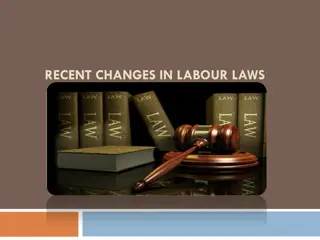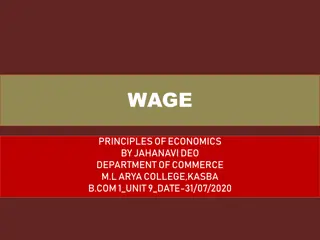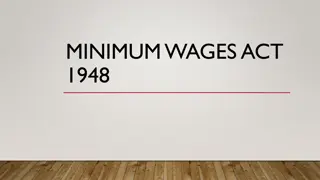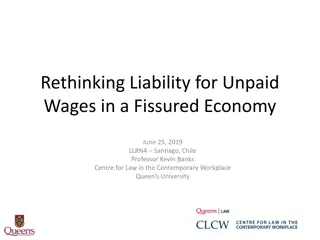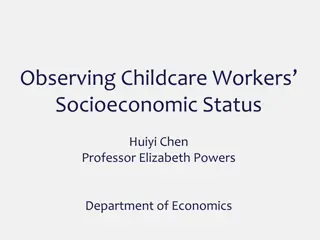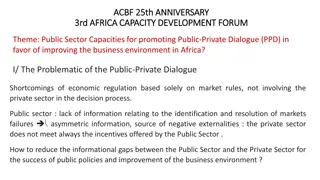
Private Sector Wages Trends and Prospects in Ireland
Explore recent trends in private sector wages in Ireland, including real compensation per employee, average weekly earnings, and sectoral wage trends. Learn about the challenges and prospects for wage growth based on data and analysis from Dr. Tom McDonnell, a Senior Economist at NERI.
Download Presentation

Please find below an Image/Link to download the presentation.
The content on the website is provided AS IS for your information and personal use only. It may not be sold, licensed, or shared on other websites without obtaining consent from the author. If you encounter any issues during the download, it is possible that the publisher has removed the file from their server.
You are allowed to download the files provided on this website for personal or commercial use, subject to the condition that they are used lawfully. All files are the property of their respective owners.
The content on the website is provided AS IS for your information and personal use only. It may not be sold, licensed, or shared on other websites without obtaining consent from the author.
E N D
Presentation Transcript
Private Sector Wages: Some Trends, Prospects and Issues 20th November 2018 (Not for circulation or citation) Dr Tom McDonnell Senior Economist NERI (Nevin Economic Research Institute) Dublin email-address@NERInstitute.net www.NERInstitute.net
Wages Trends Recent Performance
Real compensation per employee (annual % change) based on private consumption deflator (EU Commission), *forecast 2010 2011 2012 2013 2014 2015 2016 2017 2018* 2019* Ireland -1.0 -0.1 -1.2 -1.5 0.6 1.7 1.2 1.7 1.2 1.4 Euro area 0.6 -0.2 0.0 0.5 0.9 1.1 0.8 0.2 0.9 0.4 UK 1.4 -2.6 -0.4 0.4 -1.3 0.4 1.9 0.9 0.9 1.4 2010 real compensation = 100 2016 comp (Ireland) = 103.6 2018 comp (Euro area) = 104.2 2016 comp (UK) = 101.5 Ireland Commission forecast for nominal compensation per employee: 2018 = 2.5% 2018 = 2.6%
Average Weekly Earnings, Euros (All employees, Seasonally Adjusted) EHECS Annual change in seasonally adjusted earnings Q2 17 to Q2 18 = 2.8% Ten year change (Q2 08 to Q2 18) = 5.1% (0.5% per annum) Real weekly earnings grew by an average of 2% between 1938 and 2015
Average Weekly Earnings, Euros (Private sector employees, Seasonally Adjusted) EHECS 682.81 in Q2 2018 (seven years of stagnation but 7.2% growth since Q2 2015) Increases were badly distributed in the recovery period with managers/professionals receiving the fastest increases production and craft workers took a loss between Q1 13 and Q1 18 Annual change in seasonally adjusted earnings Q2 17 to Q2 18 = 2.9% Ten year change (Q2 08 to Q2 18) = 7.5% (0.7% per annum)
Average Hourly Earnings, Euros (Private sector employees, Seasonally Adjusted) CSO EHECS 21.14 in Q2 2018 Annual change in seasonally adjusted earnings Q2 17 to Q2 18 = 2.7% Ten year change (Q2 08 to Q2 18) = 9.6% (0.9% per annum)
Sectoral wage trends Q2 2013 to Q2 2018 Different time frames present different pictures. e.g. the gains for hospitality wages over the 5 year period must be considered along with the losses in the recession. Over the 10 year period hospitality wages have lagged overall wage increases.
Average Hourly Regular Earnings (Euro) by Type of Employment, (Seasonally adjusted), % increase by period Average Hourly Earnings (Seasonally Adjusted) (Euro) 2015Q2 2016Q2 2017Q2 2018Q2 15 to 18 % 17 to 18 % All employees All NACE economic sectors Mining and quarrying (B) Manufacturing (C) Construction (F) Wholesale and retail trade; repair of motor vehicles (G) Transportation and storage (H) Accommodation and food service activities (I) Information and communication (J) Financial and insurance activities (K) Real estate activities (L) Professional, scientific and technical activities (M) Administrative and support service activities (N) Public administration and defence (O) Education (P) Human health and social work activities (Q) Electricity, water supply and waste management (D,E) Arts, entertainment, recreation and other (R,S) 21.87 24.54 21.6 19.32 17.35 20.25 12.17 29.59 30.43 23.11 24.78 17.4 25.38 34.21 21.98 27.51 17.31 21.96 24.57 21.94 19.9 17.66 20.95 12.44 29.58 30.37 23.38 25.51 17.13 25.02 33.86 21.98 28.35 16.51 22.36 23.56 21.98 19.88 18.15 21.05 12.68 29.97 31.41 23.64 25.94 17.56 25.85 34.38 22.51 27.94 16.58 22.9 24.67 22.69 20.73 18.41 21.65 12.95 31.6 32.97 24.6 27.31 17.98 25.99 35.58 22.6 28.06 17.11 4.7 0.5 2.4 4.7 3.2 4.3 1.4 2.9 2.1 5.4 5 7.3 6.1 6.9 6.4 6.8 8.3 6.4 10.2 3.3 2.4 5 4.1 5.3 2.4 0.5 3.5 0.4 0.4 3.2 4 2.8 2 -1.2
Labour cost index (hourly basis) Eurostat (Business economy) Labour Cost Index 2012 = 100 o Ireland (2017) = 106.4 (19th out of 28 EU countries over the period) ; o EU (2017) = 109.2; UK (2017) = 111.9 Wages and Salaries Index 2012 = 100 o Ireland (2017) = 106.4 (20th out of 28 EU countries over the period) o EU (2017) = 109.9; UK (2017) = 111.4 (Only Greece and Spain are sub 100) If we go back further we find Irish wages lagging well behind the Euro area. Recent year-on-year changes in LCI (Q/Q-4): 2016 Q2 2017 Q2 2018 Q2 Ireland 1.4 1.9 2.9 Euro area 19 0.7 2.2 2.4 UK 2.7 2.4 2.8
Labour Costs (Euro per hour worked) Business economy in high income EU countries (at least 1 million population and GDP at least 30,000 per capita) Ireland 31.0 o Only the UK is lower amongst high-income peer countries and all bar UK and Finland are at least 10% higher. Denmark is over 37% higher. 1. Denmark = 42.5 2. Belgium = 39.5 3. Sweden = 38.3 4. France = 36.0 5. Germany = 34.8 6. Austria = 34.1 7. Netherlands = 34.1 8. Finland = 32.1 9. Ireland (Republic) = 31.0 10. UK = 25.7
Seasonally adjusted hourly labour costs in the private sector: 8.7% growth in 10 years Private sector: to Q2 18 = +2.2% Q2 17 = +1.3% Q2 16 = +1.1% 2018 Q2 = 24.79; 2017 Q2 = 24.26; 2008 = 22.81
Nominal unit labour costs: total economy: - Performance relative to the rest of the EU15: double export weights (AMECO) Note the competitive performance improves prior to the leap in GDP in 2015 Ratio of compensation per employee to real GDP per person employed (Index: 2010 = 100) Ireland = green; UK = grey; Germany = orange; Greece = blue Green is Ireland; Orange is Germany; UK is Grey; France is blue
The CPI fell by 0.9% between Sep 2008 and Sep 2018 but is up 6% between Sep 2009 and Sep 2018 The CPI is up by 1.1% between Sep 2013 and Sep 2018 and by 0.9% between Sep 2017 and Sep 2018
Prospects for Wages Future Trends
Projecting wage rates the base equation Wage Determination Log(WAGE) = a1 + a2log(OUTPUTPR) + a3log(CONSPR) + a4log(TAX) + a5log(LABPROD) + a6UNEMP + a7log(OTHER) WAGE represents the wage rate; OUTPUTPR is the price of internationally traded goods (output); CONSPR is the consumption price deflator; TAX is the tax 'wedge'; LABPROD is labour productivity; UNEMP is the rate of unemployment (this is really a proxy for the tightness of the labour market could also use sectoral/regional Job Vacancy Rates); Crucially, to what extent is the economy overheating? OTHER is everything else and includes things like trade union density Wage rates are assumed to be determined as the outcome of a bargaining process - explanatory variables: output prices (+); consumer prices (+); tax wedge (+); unemployment rate (-); labour productivity (+); 0ther (+ and -)
Is the economy overheating? Cannot directly observe the cyclical position of the economy. Most of the relevant indicators suggest that the economy is not, as of yet, overheating. Consumer price inflation has been below 1 per cent since 2012 and grew just 0.9 per cent year-on-year in September. The housing savings rate was 9.7 per cent of gross disposable income in the first quarter of 2018, a figure that is above the long-run average of 8.4 per cent. Housing completions are well below the long-run average and below the rate of new household formation.
Is the economy overheating? (cont.) Labour market performance, while improving in recent years, is unremarkable by EU standards, with unemployment and employment rates significantly worse than the best EU performers. Ireland s unemployment rate is higher than in 14 other EU countries and higher than the OECD average. The job vacancy rate, a measure of labour market tightness, is one of the weakest in the entire EU at 1.1, compared to 2.2 in the EU as a whole, and 5.4 in the Czech Republic. Taken as a whole, the evidence suggests there is some additional slack remaining in the labour market. Many of the traditional indicators (e.g. GDP) are of limited use given the distortion to the national accounts. For example, there was a current account surplus of 12.8 per cent in the first half of 2018, but this surplus includes a significant amount of contract manufacturing activity that actually happens outside Ireland.
Is the economy overheating? (cont.) On the other hand, underlying investment in the economy (i.e. stripping out IP assets and aircraft) has been growing by double digits year-on-year in each of the last three quarters, while personal consumption and retail sales are both growing relatively quickly. There is also significant asset price inflation with residential property prices experiencing double-digit growth, although property prices are still only four fifths of peak levels. In addition, average weekly and hourly wages are up 3.3 per cent and 2.8 per cent respectively year-on-year in the second quarter. As such, real wage growth is currently over 2 per cent, and this is suggestive of a tightening labour market. However, these recent gains should be viewed in the context of an almost decade long stagnation in wage growth. Similarly, the fast growth in personal consumption in the first half of 2018 follows relatively subdued growth of 1.6 per cent in 2017.
SA Employment in Q2 2018 is 35,600 up on Q2 2008 and 74,700 up on Q2 2017 Just 9 out of 14 sectors have reached or exceeded 2008 employment levels Construction (67.1%), Wholesale/Retail (90.6%) and Industry (90.5%) are among the sectors furthest from recovery ICT (130.7%), Accom/food (117.6%) and Health (116.6%) are the best performers Sectoral Job Trends (SA) Both sexes 2008Q2 2017Q2 2018Q2 Ratio 18/08 (%) Ratio 18/17 (%) 116.1 307.6 215.1 109.2 282.4 127.0 105.0 278.3 144.4 90.4 90.5 67.1 96.2 98.5 113.7 Agri, forestry, fishing Industry Construction 331.4 302.6 300.1 90.6 99.2 Wholesale/retail 91.5 92.5 97.0 106.0 104.9 Transport & storage 136.3 160.1 177.5 130.2 110.9 Accommodation/food 86.8 115.3 116.4 134.1 101.0 ICT Financial, insurance and real estate 110.9 106.3 109.8 99.0 103.3 129.4 135.3 141.2 109.1 104.4 Professional etc. 97.4 93.3 102.5 105.2 109.9 Administrative 94.6 142.2 98.3 157.1 103.8 166.9 109.7 117.4 105.6 106.2 Public admin Education 241.1 279.8 286.1 118.7 102.3 Health &social work 110.0 116.9 116.5 105.9 99.7 Other All economic sectors 2220.9 2181.8 2256.5 101.6 103.4
Total employment rates 20 to 64 years (% of pop) a long way behind best performers (we are at median) 2017 Ireland = 73.0% (joint 15th) peaked at 75.1% in 2007 before falling to 64.5% in 2012 EU = 72.2% Highest in EU is Sweden at 81.8% (Iceland is 87.6%) and lowest in EU is Greece at 57.8%
Unemployment rates Ireland is a mediocre performer (14th best in the EU) Unemployment rate seasonally adjusted September 2018 Ireland is 5.4% - joint 14th best in the EU (EU median is 5.4%) Range is Czechia (2.3%) to Greece (19.0%) Major countries: o Germany 3.4% o Poland 3.4% o USA 3.7% o UK 4.0% o France 9.3% o Italy 10.1% o Spain 14.9% Is there such a thing as a normal unemployment rate? Still room for further strengthening in the labour market labour market is not yet tight , though sectoral specific tightness (e.g. in ICT) may exist
Unemployment is trending downwards in all regions State = 6.0% in Q2 (regional variation = 5.3% to 9.7%) Midlands is the poorest performer
EU job vacancy rate (JVR) of 2.0% in Q2 2017 and 2.2% in Q2 2017 Czechia has the highest JVR at 5.4% while Greece is lowest at 0.7% Ireland has a relatively low job vacancy rate ..suggests a soft labour market 2017 Q2 2018 Q1 2018 Q2 EU 28 2.0 2.2 2.2 Ireland 1.1 1.0 1.1 Germany 2.7 2.9 2.9 United Kingdom 2.6 2.5 2.7 Spain 0.8 0.9 0.9 Rate = Job vacancies/(occupied posts + no. of job vacancies)*100 Ireland is just 20th out of 24 EU countries
JVR suggests labour market is particular soft in construction (0.3%) and retail (0.6%) Even so, I anticipate these demand led sectors will experience employment growth Job Vacancy Rates by Sector slow improvement Disparity between sectors 2012 Q2 2016 Q2 2017 Q2 2018 Q1 2018 Q2 All Industry Construction Wholesale/retail Transport/storage Accommodation/food Information/communication Professional/science/tech Admin and support Public admin/defence Education Health/social work Financial/insurance/real estate Arts/entertainment/other 0.5 0.6 0.2 0.3 0.2 0.4 1.5 0.6 0.6 0.4 0.3 0.4 2.1 0.4 0.9 0.8 0.3 0.6 0.3 0.4 1.9 1.3 1.1 1.4 0.7 1.1 2.3 0.9 1.1 0.7 0.2 0.6 0.8 0.9 1.8 2.5 1 1.1 0.8 0.6 0.6 0.9 0.7 0.8 0.5 0.5 0.6 0.6 2.1 2.5 1.1 1.3 0.5 1.2 2.1 0.7 2 2.4 1.3 1.3 0.8 1.6 2.2 0.7 1 1.4 0.9 1.3 2.5 1
Irishjobs.ie suggests vacancy-employment rates are highest in the East and low in the Midlands IrishJobs: Every county bar 3 (Clare, Kerry, Donegal) recorded a year-on-year increase in job vacancies in Q3 2018 o Dublin +19%; Cork +5%; Limerick +2% Largest share of job vacancies is in hotel/catering Job Vacancy Rates (JVRs) highest in Dublin, Carlow and Limerick JVRs lowest in Kerry, Cavan, Donegal and Midlands counties 4% annual increase in Job Vacancies in Q3 18 with a 15% increase in Accountancy/finance and 8% in construction/property
Job vacancy and labour market context.. Scenario 1: High vacancy and low unemployment Suggestive of a tight labour market most consistent with wage inflation Scenario 2: Low vacancy and low unemployment Consistent with baseline wage growth Scenario 3: High vacancy and high unemployment Suggestive of a mismatch between the education/skills profile of the labour force and employer requirements differentiated wage growth Scenario 4: Low vacancy and high unemployment Associated with recessions or structurally poor performance and weak wage growth We moved from Scenario 1 (circa 2003-2008) to Scenario 4 (circa 2009-2015) Scenario 2 most accurately describes the current situation this has important implications for wage growth. A return to Scenario 1 is feasible and would arise if the economy was overheating for an extended period
Dept. Finance Labour Market Expectations, % growth (Budget - Oct, 2018) % change 2017 2018 2019 2020 2021 2022 Real GDP 7.2 7.5 4.2 3.6 2.5 2.6 Real GNP 4.4 5.9 3.9 3.3 2.3 2.4 Employment 2.9 3.0 2.8 2.2 1.5 1.6 Unemployment (rate) 6.7 5.8 5.2 5.0 5.0 5.0 Compensation of employees 5.4 5.6 5.6 5.4 5.2 5.0 Compensation per Employee 2.2 2.8 3.1 3.2 3.4 3.4 Labour productivity (per person employed) 4.2 4.4 1.4 1.3 1.0 0.9 Inflation HICP 0.3 0.7 1.5 1.7 2.9 2.4 Personal consumption deflator 1.4 1.5 2.0 2.1 2.9 2.4
Institutional Forecasts for 2019 Employee Compensation and Inflation Compensation per Employee o Dept. Finance: 3.0% o ESRI: 2.9% (Average Hourly Earnings) o Central Bank: 3.3% o NERI: 3.4% (Average Hourly Earnings) Harmonised Index of Consumer Prices o Dept. Finance: 1.5% o ESRI: 1.1% o Central Bank: 0.8% o IMF: 1.2% o EU Commission: 1.3% o OECD: 2.1% General consensus that unemployment will fall in the short-term o Dept. Finance: 5.2% o Central Bank 4.7% o ESRI 5.1% o NERI 5.2%
Establishing a Baseline Considerations
A Baseline? (All things equal) Nominal compensation must rise in line with inflation just to hold steady in terms of real compensation consumer inflation is likely to average circa 1.99% over the medium-term (the ECB target) Ireland s higher than average growth potential might influence upwards implying inflation in the 2-2.5% range over the medium-term Labour productivity should be compensated through real pay increases likely to average 1% to 1.5% over the medium-term (i.e. post WW11 norms in the advanced Western economies) Baseline claim is inflation + productivity (Table below shows Dept. Finance forecasts) Baseline claim should then adjust for other factors e.g. is the labour share of income low or even in decline? how tight is the sectoral labour market? What about corporate performance? % change 2019 2020 2021 2022 2023 Five year average (19-23) Labour productivity 1.4 1.3 1.0 0.9 0.9 1.1 Inflation (personal consumption deflator) 2.0 2.1 2.9 2.4 2.6 2.4 Baseline (before compounding) 3.4 3.4 3.9 3.3 3.5 3.5
Realism of long-term trends (OECD data) Department of finance 5 year projection for labour productivity growth = 1.1% Historical trends Annual growth in GDP per hour worked, constant prices G7: 1995-2016 = 1.5% o G7: 2001-2016 = 1.2% o OECD: 2001-2016 = 1.2% o EU: 2001-2016 = 1.1% Ireland: 1995-2017 (excluding 2015) = 3.5% o However, multinational activities (e.g. transfer pricing) significantly pollute the Irish data 1.1% is plausible
Are baseline assumptions realistic? HICP Inflation (HICP includes rural consumers but excludes owner occupied housing) Annual Average rate of change 1996-2000 2001-2005 2006-2010 2011-2015 2016-2017 Average EU 4.6 (97-00) 2.5 2.3 1.5 1.0 2.5 Ireland 2.3 3.4 1.1 0.8 0.1 1.7 UK 1.6 1.5 2.7 2.3 1.7 2.0 USA 2.7 (99-00) 2.4 2.4 1.5 1.1 2.1 2% average is plausible - close to the average for Ireland (1.7%) the UK (2%) and the US (2.1%) Significant uncertainty surrounds the short-term path of inflation but a 2% medium-term assumption is reasonable and faster price growth will be expected if the cyclical upswing continues
Other Considerations Context
Adjusted Wage Share: total economy (% of GDP ) EU Commission AMECO 1995: o Ireland = 59.7% o Euro area (current composition) = 64.5% o UK = 59.9% 2014: o Ireland = 50.2% o Euro area = 63.4% o UK = 65.9% 2018: o Ireland = 36.1% Ireland GNI* = 58.7% o Euro area = 62.8% o UK = 66.9%
Assessing Corporate Performance ostensibly a benign environment for corporates Revenue Y-on-Y % change (to end October) o Corporation tax (6.74bn) +24.3% o Capital gains tax (0.29bn) +31.8% o VAT (11.81bn) +5.3% o Excise (4.42bn) -10.7% Annual retail sales (volume) were up 6.5% in September (6.3% excluding cars) consumer sentiment index was 93.5 (declining year-on-year but still above average) Personal consumption (volume) grew 4.4% in Q2 Services PMI is very strong (58.7 where >50 represents expansion) Manufacturing PMI is also positive (54.9) ..
Gross Operating Surplus ( billions) Ireland Source: European Commission AMECO (* = forecast) What about corporate profits? Gross Operating Surplus is akin to earnings before income, tax, depreciation and amortisation (EBITDA) which in turn is a relation of taxable income Officially GOS doubles between 2014 and 2018. Unfortunately the headline figures are of limited use due to profit dumping by multinationals 2013 = 94.4 bn (5.0% growth) 2014 = 105.7 bn (12.0% growth) 2015 = 167.3 bn (58.3% growth) 2016 = 172.0 bn (2.8% growth) 2017*= 188.7 bn (9.7% growth) 2018* = 211.6 bn (12.1% growth)
Gross Value Added ( billion constant 2016 prices) Sector 2013 2014 2015 2016 2017 Foreign- owned MNE dominated 44.14 49.59 91.22 97.07 107.18 Non-MNE dominated sectors 130.26 (+2.8%) 138.35 (+6.2%) 150.04 (+8.4%) 158.14 (+5.4%) 164.98 (+4.3%) Total 175.74 189.67 241.20 255.22 272.16 GVA growth in 2017 in selected sectors of origin (constant price): Industry (excluding construction) +7.6% Construction +15.2% Distribution, transport, hotels & restaurants +1.7% Financial and insurance activities +2.4% ICT +16.0% Professional, administration and support services +11.2% Public administration, education and health +2.1%
ECB targeting and real wage growth Assume inflation is always at the ECB target of 1.99% and labour productivity improves 1.5% in all years Sample nominal wage growth Equivalent real wage growth Sample nominal wage growth Implied real wage growth Cumulative productivity growth By Year 1 1.99 0 3.00 1.01 1.50 By Year 2 4.02 0 6.00 1.98 3.02 By Year 3 6.09 0 9.00 2.91 4.57 By Year 4 8.20 0 12.00 3.80 6.14 By Year 5 10.35 0 15.00 4.65 7.73 Compounding Baseline = 3.49% in year 1; 7.10% in year 2; 10.84% in year 3; 11.47% in year 4; 18.71% in year 5
Is there a universal number? Context is everything Sectoral/regional/individual realities are heterogeneous Also, is compensation currently in line with productivity? (stripping out the MNEs) o Should there be a labour share target? Perhaps as a proportion of GNI* o Is compensation currently in line with competitor economies? o Productivity growth will depend on sectoral composition of job creation/destruction Long-term inflation of 2% (medium-term could very well be 2% to 2.5%) o Compensation needs to increase by at least this amount each year to avert declining living standards (ignoring changes to tax policy). Should there be a minimum annual demand in terms e.g. 1,000?
Quick and dirty based on Dept. Finance assumptions Labour productivity Personal consumption deflator Single year claim Multiannual claim 2019 +1.4% +2.0% 3.4% 3.4% over one year 2020 +1.3% +2.1% 3.4% 6.9% over two years 2021 +1.0% +2.9% 3.9% 11.1% over 3 years 2022 +0.9% +2.4% 3.3% 14.8% over 4 years 2023 +0.9% +2.6% 3.5% 18.8% over 5 years Note there are compound effects at play in the last column Increasing the labour share implies larger claims
Private Sector Wages: Some Trends, Prospects and Issues 20th November 2019 (Not for circulation or citation) Dr Tom McDonnell Senior Economist NERI (Nevin Economic Research Institute) Tom.mcdonnell@NERInstitute.net www.NERInstitute.net







